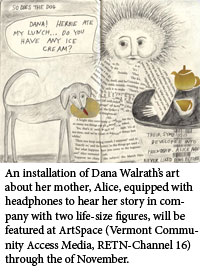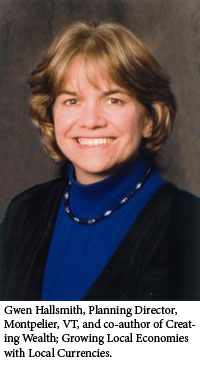Crea’s Lintilhac Foundation:
Family Funds and Inherited Values
“If you want to accomplish anything, it’s important that you focus,” says Crea Lintilhac. The Lintilhac Foundation focuses on issues valued by her and the foundation’s creator, Crea’s mother-in-law Claire Lintilhac. Under Crea’s watchful direction, the Lintilhac Foundation dispenses small annual grants to dozens of local community initiatives and major funding for nurse-midwives, birthing and breastfeeding programs at Fletcher Allen, as well as alternative energy development and environmental studies at the University of Vermont. Despite dispensing $500,000 to $1,000,000 a year in grant funds, Crea does not think of herself as a philanthropist. “It’s a means to an end,” she says. “The Lintilhac Foundation is really a composite of all the work people do in their communities.” In 1976, Crea Sopher was doing graduate work in science education and geology at UVM; her roommate was a botany student, who came home one day with news of her professor’s bad car accident. She wanted company going up to the hospital to visit him. So Crea went with her to Fletcher Allen, and the professor in bed with a broken leg was Phil Lintilhac. Phil’s mother Claire was also visiting, and the three quickly engaged in conversation about laboratory testing standards and treatment at the hospital. Three months later, Phil called Crea and asked her out on a date—to Shelburne Farms to hear a piano concert. Phil and Crea were married in 1983 at the Stowe Community Church. “Claire invited everyone in the town,” Crea recalls with a laugh. “The whole fire department, everyone, and all these Chinese people she knew from New York. After the service we went to the Stowehof for the reception outside, and there was this absolutely huge electrical storm, lightning crashing everywhere, and the Chinese kept saying, ‘Very auspicious, very auspicious.’” An avid amateur pianist herself, Crea now lives with Phil in a house on Lake Champlain surrounded by the Shelburne Farms grounds. It’s a sunny home filled with light woodwork, bright artwork and a Yamaha grand piano. They have three children: Louise, 27; Will, 23; and Paul, 21, a student at Dartmouth.
Read the full article |
|
| |
|
Memory Care in Vermont: Understanding Alzheimer’s and Related Dementias
Dr. Dana Walrath’s mother, Alice, is 77-years old and has Alzheimer’s disease. Dana and her family cared for Alice in her home in Underhill for over two years. In her blog, called “Alzheimer’s through the Looking Glass,” Dana, a medical anthropologist and professor at the University of Vermont, Department of Family Medicine, writes:
“‘Dana, am I going crazy? You would tell me if I had lost my marbles, wouldn’t you?’ I’ve heard these questions many times. Repetition. Anyone who lives with Alzheimer’s knows from repetition. As her rudder, I always supplied my mother, Alice, with the same steady answers. ‘No. You’re not crazy. You have Alzheimer’s Disease so you can’t remember what just happened.’ ‘Oh. I forgot. What a lousy thing to have.’ ‘Would you like a cup of tea?’ ‘Ohhh, I would love a cup of tea.’ This ritual soothed us both. As an anthropologist, I know from ritual and how it uses repetition to soothe worries, to fill in the unknown, to make things better.”
Alzheimer’s is a progressively worsening brain disorder which affects memory and intellectual abilities enough to interfere with daily life. Brain cells die over time and lead to specific tissue abnormalities identifiable on autopsy. While the cause is not fully understood, genetic, environmental and lifestyle correlations have been identified. Medications and natural treatments exist to treat symptoms in the early stages, but they are widely considered to be ineffective as the disease progresses. There is currently no known cure.
Read the full article |
 |
| |
|
An Economy of Our Own: Avoiding Another Jack-Ass Monetary Crisis
The great feminist Andrea Dworkin put it this way in 1981. “Money speaks,” she said, “but it speaks in a male voice.” We know this better than ever since 2008. As the financial fog begins to lift on the fraud and gobbledygook of economic Wall Street and Washington, it feels a little like walking in uninvited on a jack-ass frat party. Eeee-ooooh. You actually do that?! How can anyone be so stupid??!!
Feminists aren’t the only ones to notice how male-dominated this crisis has been. Ken Hirschhorn, a trader at Long-Term Capital Management, a prominent hedge fund whose collapse in 2000 foreshadowed 2008’s melt-down, told Sheelah Kolhatkar of New York Magazine, “I don’t think greed is gender specific. But if you ask me whether Long-Term Capital Management would have blown up if there were more women involved in the decision-making process? A woman might have said, ‘Let’s not assume we’ll never be wrong.
Kolhatkar also talked to Joe Herbert, a neuroscientist who studies finance at Cambridge University. He said, “The banking crisis was caused by doing what no society ever allows, permitting young males to behave in an unregulated way. Anyone who studied neurobiology would have predicted disaster.”
The question is what to do about the reeking mess left behind. How do we prevent another monetary jack-ass crisis? Growing numbers of critics agree we cannot continue to do more of the same. But how can women make a difference?
Read the full article |
 |
| |
|
Then. Now. Next.
This issue marks the completion of eight years of publishing Vermont Woman. Combined with the first incarnation of our newspaper, 1985-1990, that makes thirteen. That’s thirteen years of publishing a newspaper dedicated to providing a platform for women’s voices, and written nearly entirely by Vermont women.
Lest you think this unremarkable, I urge you to pause and reflect with us about what this has meant to the Vermont community, both women and men, and to the Vermont media mix. What does the future hold for the continuance of such a publication?
The genesis of Vermont Woman began 26 years ago, riding high on what came to be referred to as the second wave of feminism, originally ignited by Betty Friedan’s The Feminine Mystique in1963. Supported by a survey of thousands of married women who revealed wide spread dissatisfaction, Friedan developed her groundbreaking work. It became a radical indictment of the way women, post-WWII, were leading their lives. She attacked the pervasive belief and myth of suburban women’s domestic fulfillment, which held that no matter how educated, her life was entirely one of chores, children and caring for her husband. Millions of copies were sold, translated into dozens of languages, and thus began a social upheaval not seen since the suffragette movement at the turn of the century.
Read the full article |
 |
|